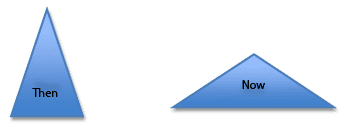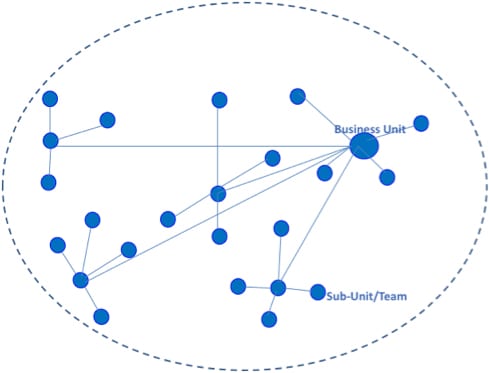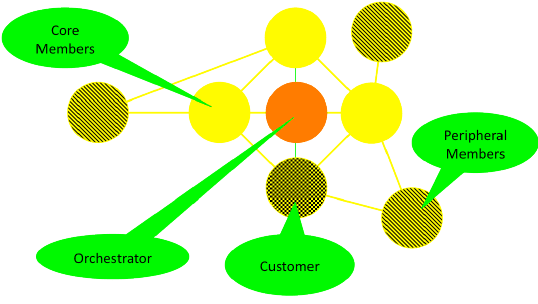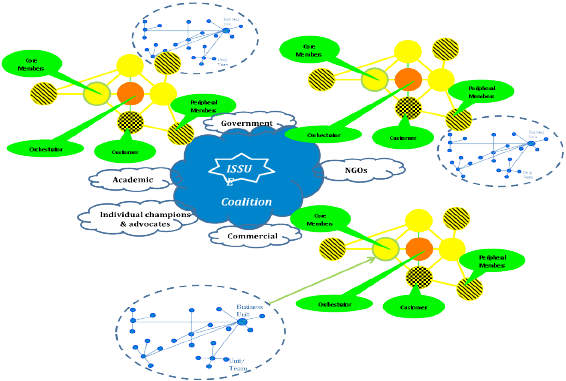If you have been following previous blogs, you will recall me mentioning an STS-RT (Socio-Technical Systems Roundtable) research and discovery process in which I am involved. The journey my colleagues and I ventured into was to understand and document changing organizational forms and functioning—present day as well as future. After more than five years of collaborative action research, the Discovery Team (R & D function of the STS-RT) has integrated its collective learning into visual images or thought models so as to better enable our understanding and knowledge transfer. The adage, a picture is worth a thousand words, holds even more truth in translating complex, unpredictable experiences.
Nothing you will see in the images below is cast in stone. We are still in the “design phase” of the discovery cycle and will seek further input from our STS community during a September 28, 2011, learning event in New Orleans. Having said this, over the next few weeks, I intend to share pieces of the overall model here on my blog. My rationale is two-fold: to give me an opportunity to synthesize our thinking, and to test out others’ reactions to the images and language forming the basis of our model.
Today’s blog will focus on the three organizational contexts and models within which we find ourselves designing (i.e., organizational form). Next week’s blog will cover the transformational process models for each of the three contexts (i.e., organizational functioning). In the following weeks, other design elements will also be shared. That is:
• what we design,
• ideals to guide the design process,
• criteria or principles for the product of the design process, as well as,
• design methods and tools.
Throughout, I look forward to hearing your thoughts and suggestions.
Three Design Contexts (Organizational Form)
In 1995, Jay Galbraith, wrote “organizational design decisions are the shapers of the organization’s decision process” and what shapes the organizational design is strategy. Therefore, different organizational strategies require different designs. During this same time period, knowledgeable, demanding consumers were shaping organizational form through
• their increased buying power,
• the variety and customization they were requesting,
• the speed at which they wanted their demands met and
• the rapidly changing environments and circumstances within which they lived.
Creating knowledge-based organizations with effective, rapid response to meet these customer demands necessitated many more decisions and many more people in the decision-making process.
As witnessed over the past 16 years, the resulting organizational designs have seen greater and greater decentralization or flatter hierarchies as depicted below:

For the most part, today’s organizational designers find themselves facing these same “shapers” (empowered consumers, variety, rapid change and speed) but with additional complexities. The STS-RT discovery process further specified these complexities as characteristics of adaptive enterprises—self-organizing, transformational, simplified, nested, rapidly prototyped and simultaneously explorative and exploitative.
Even further specification emerged into three design possibilities below:
- Hierarchically-integrated, Decentralized Organization – multiple sub-units/teams within a Business Unit bound by shared resources
- Value Realization Network – multiple entities within an environment bound by shared outcomes
- Social Eco-system – multiple entities within an environment bound by shared will for issue resolution
Hierarchically-integrated, Decentralized Organization:
This organizational form is most commonly seen in today’s enterprises. The Business Unit might constitute a specific product line (desktops, laptops, mobile phones or tablets) with its support functions—research and development, hardware design, software design, marketing and sales. The Sub-units or teams could embody a specific model of that product line (4-G laptops) along with its support functions—dealers, mass retailers, direct sales and mail order.
The boundary “line” is permeable to the outer world but contains one or several business units within a decentralized, but still hierarchical structure.
Value Realization Network:
Although not as visible as the hierarchically-integrated and decentralized organization, value realization networks form within and between businesses around a shared outcome (a product or service such as a new treatment for breast cancer) and are typically facilitated by communication technologies due to a geographically dispersed membership. The circles or nodes indicate people or roles—orchestrator, customer, core members, peripheral members. The connecting lines are the interactions among these members that produce deliverables such as knowledge, financial value and other benefits. These value-creating deliverables emerge from complex, dynamic and interdependent relationships where “all participants are emotionally, economically, ecologically and/or morally self-reliant while at the same time responsible to each other”.
Social Eco-system:
The Social Eco-system embodies both of the previously described organizational forms as well as an organizing Issue Coalition made up of governmental/non-governmental organizations, academia, commercial enterprises and individual champions or advocates. What they all hold in common is the shared will to resolve an issue (i.e., reduction of poverty in Canada). Their shared will is fortified by a set of shared ideals—humanity, community, nurturance and beauty.
What is your experience with all or any of these organizing forms? What would you say is missing or could be better illustrated?
Sources:
Galbraith, Jay R. 1995. Designing Organizations: An Executive Briefing on Strategy, Structure and Process, San Francisco: Jossey-Bass.
STS-RT Integration Team. 2011. Matrix of Emerging STS Design in 21st Century Organizing.







